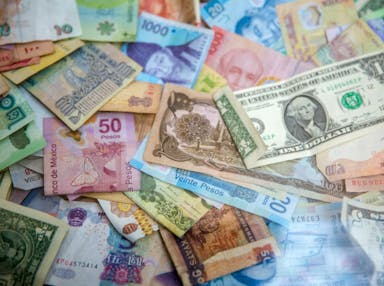
Compliance Risk: How To Assess and Manage It in 2026 [+ Templates]
Anna Fitzgerald
Senior Content Marketing Manager
Rob Gutierrez
Senior Cybersecurity and Compliance Manager, CISA, CCSK, CMMC RP
Data breaches cost nearly $220,000 more when noncompliance with regulations was indicated as a factor in the event. And in 2026, that cost gap is expected to widen as regulators tighten enforcement, introduce higher penalties, and expand new rules around AI and cyber resilience.
Regardless of the industry your business operates in, understanding the implications of non-compliance will protect your business from various ramifications ranging from costly data breaches to reputational damage.
Compliance risk is the potential consequences your organization will face should it violate industry laws, regulations, and standards.
In this article, we dig into the most common types of compliance risk and explain how to evaluate your organization’s exposure. We also share best practices for assessing and managing compliance risk so you can stay ahead of 2026’s evolving regulatory environment and keep risks within acceptable levels for your business, your board, and your regulators.
What is compliance risk?
Compliance risk, also known as integrity risk, is the potential damage businesses face when they fail to comply with industry standards, laws, and regulations. This risk involves both financial penalties and reputational damage.
Organizations of all shapes and sizes are exposed to compliance risk, from the smallest small business to the largest enterprise company.
For example, a small chiropractic clinic faces compliance risk if they fail to meet HIPAA compliance standards in the same way that a large hospital system would.
To manage compliance risk effectively, an organization must:
- Identify all applicable laws, regulations, and standards that affect the business
- Conduct risk assessments to discover areas where the organization fails to meet industry laws, regulations, and standards
- Implement controls and procedures to effectively comply with industry laws, regulations, and standards
- Keep up with updates and changes to the laws, regulations, and standards that shape their industry
We’ll discuss compliance risk management in more depth below, starting with why it's important to mitigate the likelihood and potential impact of compliance risks.
Recommended reading

Regulatory Compliance Risk Management: Frameworks, Best Practices, & How to Do a Risk Assessment
Compliance risk management reasons: Why you need to mitigate compliance risk
The importance of managing compliance risks goes beyond a sense of professional obligation or protecting your bottom line.
Organizations that fail to proactively manage compliance risks expose themselves to reputational, business, financial, and legal consequences that can disrupt day-to-day operations. Let's take a look at four key reasons to manage compliance risk below.

1. Prevent reputational damage
Failing to comply with industry standards, laws, and regulations can damage your reputation. When your company’s name is in the news for poor compliance risk management, it’s difficult for customers to trust you.
Don’t let your reputation suffer due to a breach or by falling out of compliance.
2. Avoid business disruptions
As a business owner, you do not want anything to disrupt your company's ability to operate. Yet failure to comply with certain industry standards can lead to business shutdowns or impact to the way you run your business.
For example, non-compliance with the Payment Card Industry Data Security Standard (PCI DSS) could lead to the suspension of your ability to accept major credit cards like Visa and Mastercard. Customers might avoid purchasing from your company or walk away if they do not have another payment type with them.
3. Protect financial stability
The financial impact of poor compliance risk management can be drastic. Lost investors, property, and overall revenue can result from strikes on your account, breaches, shutdowns, and more.
Financial implications from non-compliance include:
- Loss of investors
- Loss of revenue
- Legal fees
4. Reduce legal exposure
If you fail to comply with industry standards and best practices, your legal action may be brought against your company and/or employees.
This can lead to costly fees, penalties, imprisonment, exclusion, or forfeiting products and property. For businesses unable to handle the financial burden, legal issues can often lead to a company shutdown.
In short, compliance risk management isn’t just about avoiding fines and penalties—it’s about protecting your brand, keeping your business running smoothly, safeguarding revenue, and staying on the right side of the law.
Recommended reading

Biggest Data Breaches of 2024: What Went Wrong and Key Lessons for Strengthening Cybersecurity
What are the types of compliance risks?
Compliance risk is something all organizations might face, no matter the industry. Below we discuss the most common types of compliance risk.

Privacy and data security
Impact: Legal, financial, reputational
Proper handling of sensitive and confidential data is critical for protecting employees and customers.
Thankfully there are several laws in place to help protect the privacy of individuals. A few of them include:
- The Health Insurance Portability and Accountability Act (HIPAA) limits the use and disclosure of patient’s protected health information (PHI).
- The European Union General Data Protection Regulation (GDPR) allows EU citizens to control how their personal data is collected and stored by organizations.
- The California Consumer Privacy Act (CCPA), similar to GDPR, gives Californians greater control over how businesses use their personal data.
- The EU AI Act, which is expected to be enforced in August 2026, is designed to build upon GDPR, reinforcing the fundamental right to data protection when using AI systems
Workplace health and safety
Impact: Legal, financial, business, reputational
One of the most serious types of compliance risk is workplace health and safety. From accidents to repetitive injuries, risks can happen in any work environment.
Countries have specific health and safety processes that all organizations and their employees must comply with. The Occupational Safety and Health Administration (OSHA) and U.S. Food and Drug Administration (FDA) have enforced significant penalties to ensure the health and safety of employees.
Even in low-risk environments such as offices, accidents such as slips and falls still happen.
Ensure your organization meets industry and federal standards by knowing when and how to report accidents should they occur. Additionally, offer workplace safety training should your industry require it.
Corrupt or illegal activities
Impact: Legal, financial, business, reputational
A common type of compliance risk is corrupt or illegal activities. Fraud, theft, bribery, or money laundering are all examples of corrupt and illegal activity.
As defined in the Foreign Corrupt Practices Act (FCPA) of 1977, it is unlawful for certain individuals to make payments to foreign government officials to help aid in obtaining or retaining business. Under the FCPA, bribery is also unlawful and no form of money should be offered, promised, or given in any organization.
Process risks
Impact: Business, financial
Process risks refer to day-to-day operations that violate rules and regulations within your industry. Some examples include poor quality assurance, improper machinery maintenance, or even reporting and accounting errors.
Another example of process risk is human error, which is an unpredictable and unintentional error such as a mental slip. One way to help avoid this is to offer regular training opportunities and ensure that staff know that lines of communication are open at all times.
Environmental impact
Impact: Legal, financial, business, reputational
The Environmental Protection Agency (EPA) is the federal office in charge of overseeing an organization’s environmental impact. Their main focuses are human health, and ecological effects.
The potential damage to any and all living organisms and the environment inside and outside of the workplace falls under EPA jurisdiction.
Companies that have any impact on the environment (such as taking or emitting things into the environment) are required to comply with environmental laws and regulations issued by the EPA such as the Clean Air Act and the Clean Water Act.
Social impact
Impact: Reputational, business
Social compliance is how a company protects the health and safety of employees, its community, and the environment where it operates. How a company approaches social compliance is often governed by its perspective on social responsibility.
Human rights, diversity, inclusion, community engagement, labor standards, and cybersecurity practices all fall under the social impact compliance umbrella.
Today, employees and consumers are seeking companies that hold moral standards that mirror their own. Poor internal policies on social issues can lead to boycotts and protests either by employees or customers.
Quality standards
Impact: Legal, business, financial, reputational
Quality compliance risk involves the release of lower-quality products or services that fail to meet industry standards.
For instance, the U.S. Consumer Product Safety Commission (CPSC) works to reduce the risk of injuries and deaths caused by consumer products. By complying with these industry standards, your company can help save lives and prevent injuries.
Failure to create products that meet CPSC standards can lead to costly consequences such as eating the cost of a product that can’t be sold and addressing the problems that led to non-compliance.
These categories aren’t just theoretical. Over the years, companies like T-Mobile, Novus Hospice, and Ashley Furniture have faced major penalties for compliance failures. Let’s look at real-world examples below.
Real-world compliance risk examples and consequences
Understanding the different types of compliance risks is important, but seeing how they play out in real life makes the impact even clearer. The following examples highlight some of the most significant compliance failures in recent years, including new cases from 2024 and 2025. They span privacy and data security, social impact, workplace safety, and the other types of risk discussed above.
These examples illustrate just how severe the consequences of non-compliance can be—from massive data breaches to workplace safety violations—and the penalties that follow.
| Type of compliance risk | Real-world example | Details | Penalties |
|---|---|---|---|
| Privacy or data security | Solara Medical Supplies (2025) | OCR investigation of two data breaches exposing the protected health information of over 100 thousand people uncovered potential HIPAA violations. | $3 million settlement |
| Workplace health and safety | Ashley Furniture (2015) | OSHA fined Ashley Furniture after over 1,000 employees were injured over the course of three years. | $1.75 million fine |
| Corrupt/illegal activities | Aero Turbine Inc. & Gallant Capital Partners (2025) | Settled allegations under the False Claims Act for failing to implement required NIST 800-171 cybersecurity controls on a U.S. Air Force contract. | $1.75 million settlement |
| Process risks | GOAT (2024) | FTC settlement for violating shipping rule requirements, misrepresenting consumer protections, and failing to meet promised shipping practices. | $2.01 million in refunds and compliance obligations |
| Environmental impact | HF Sinclair Navajo Refining LLC (2025) | EPA and DOJ settlement for Clean Air Act violations due to excess hazardous air pollutant emissions at New Mexico refinery. | $35 million fine + $137 million in compliance investments |
| Social impact | Glow Networks Inc. discrimination suit (2022) | 10 former employees won a federal discrimination suit alleging racial discrimination and a hostile work environment. | $70 million in damages |
| Quality standards | Bestar (2024) | Knowingly failed to report that its wall beds posed a serious crushing hazard, despite 35 incidents including one fatality. | $16.025 million civil penalty |
Dive deeper into high-profile cases of non-compliance with regulations and laws like HIPAA, GDPR, CCPA from the past two years. These fines and sanctions reveal how non-compliance can outweigh every short-term compliance effort and reinforce why proactive compliance risk management is not just important, but essential for businesses to be successful.
Expect to see more headline-making fines in 2026 as regulators increase enforcement and introduce higher penalty thresholds.
Recommended reading

Biggest Non-Compliance Fines in Recent Years + Why It’s More Expensive Not to Comply with Regulations
Compliance risk assessment template
A compliance risk assessment is the foundation of effective compliance risk management and key to avoiding significant fines and penalties like the ones above.
To help you get started, we’ve created a customizable template you can use to identify and track your business’s top compliance risks. Use it as a starting point and customize it as needed to fit your business and the industry standards, laws, and regulations it must comply with.
After you’ve downloaded the template, follow the steps below to conduct a thorough compliance risk assessment. These steps will help you not only identify risks, but also evaluate, prioritize, and treat them in a consistent way.

Compliance Risk Assessment Template
Performing compliance risk assessments is a key part of managing risk and maintaining compliance. Use this template to identify and track risks that could threaten your company’s ability to adhere to industry laws, regulations, and standards.
How to conduct a compliance risk assessment
To fully understand the compliance risk your business faces, you need to conduct a compliance risk assessment. These assessments evaluate potential risk factors that could threaten your company’s ability to adhere to industry laws and regulations. Performing them periodically is a key part of compliance risk management.
Below are key steps to assessing compliance risk.
1. Identify compliance requirements
Compile a list of all the regulatory requirements that apply to your business and identify compliance gaps.
You can download this template to identify all applicable laws, regulations, and standards that affect your business. This will be the starting point for your compliance risk management efforts.
2. Send out a compliance risk assessment questionnaire
In order to successfully identify, analyze, prioritize, and mitigate compliance risks, you need to understand the departments and outcomes that would be affected by potential risks.
A compliance risk assessment questionnaire can be a powerful way to gather feedback from key stakeholders in different departments in order to get a more complete assessment of the risks that your organization faces.
Based on the results of the questionnaire, you can understand more clearly where you need to allocate resources to mitigate risks.
Here are some sample questions you may include in your questionnaire:
- Does the company have a risk assessment process in place?
- Do you agree with the top risks that have been identified by organizational leadership?
- What operational controls exist to ensure compliance with applicable industry standards, laws, and regulations?
- What is the process for developing and updating the department policies and procedures?
- How do you verify policies and procedures are being accurately implemented?
- Do you feel confident in identifying and reporting potential compliance issues?
- How are the risks to the organization currently managed?
- What is the process for training the department on internal and/or external compliance requirements?
- Do you work with any third-party vendors or partners? If yes, do you believe that these third parties adhere to the organization’s compliance standards?
- Do you operate in any countries or jurisdictions that require you to comply with any specific frameworks, laws, regulations?
3. Evaluate the likelihood and potential impact of each risk
Using quantitative or qualitative measures, assess the likelihood that each risk will occur and the level of impact or magnitude of harm that can be expected if it does occur. This will help determine your inherent risk exposure, which is the exposure to risk that exists in the absence of controls or mitigation strategies.
If you're not sure how to do this, download this Risk Assessment template as a starting point for assessing risks. It is tailored for non-adversarial risk, but you can use it to assess adversarial risk by replacing “range of effects” with “threat source characteristics.”
Like a template, risk assessment software can also help simplify and streamline this process. In addition to helping ensure each risk is assessed and reported in a consistent and repeatable manner, risk assessment software can also help save you time. Secureframe, for example, offers Comply AI for Risk to automate the risk assessment workflow. This eliminates manual analysis and provides almost instantaneous insights into each risk based on the risk description and company information, including its potential impact, likelihood, and recommended treatment, with clear justifications for each output.
4. Prioritize severe risks
Address compliance risks based on their likelihood to occur and the severity of the impact they pose to your business. You’ll want to prioritize mitigation efforts for severe risks. Risk mitigation refers to remedial or corrective actions taken to reduce the level of risk until it falls within the organizational risk tolerance. Mitigating efforts may include operational processes, policies, and technologies designed to reduce the probability or impact of a risk. For example, conducting regular information systems backups can help mitigate the risk of accidental data loss.
Once you mitigate risks at the highest level, you can continue addressing the lower levels as time and resources allow.
5. Indicate risk treatment decision and plan
While risk mitigation is the most common, there are other ways you can respond to risks. You can accept risks as is. You can transfer or share them. You can avoid them. You can remediate or resolve them.
Here is how you should think about each risk response:
- Risks that fall within your organization’s risk tolerance levels can be accepted. The only risk response needed is monitoring.
- Risks that can be reduced to an acceptable level in a cost-effective way should be mitigated or transferred. You may respond to these risks by implementing controls that help prevent or limit the loss if a threat event occurs.
- Risks that cannot be reduced to an acceptable level in a cost-effective way should be avoided.
- If a solution or remediation is implemented, a risk can be resolved.
For every risk identified in a risk assessment, decide on a risk response, then create and share risk treatment plans with stakeholders for addressing potential risks if they were to happen.
Creating a risk register can help your organization keep track of these risks and treatment plans and adjust them over time to keep overall risk within the organization’s tolerance.
Risk register software makes it painless to create a risk register and keep it up-to-date with new risks and information. The Secureframe risk register and risk dashboard, for example, areeasy to update and view at-a-glance so your organization can stay aware of and assess risk changes, review risk and performance results, and continually improve its risk management processes to help the organization achieve its objectives. Learn more about Secureframe's new Risk Management tool.
6. Evaluate residual risk
Determine the extent to which these actions would reduce risk. Effective risk mitigation strategies, like employee training, can reduce the likelihood and potential impact of compliance risks. The risk that remains after treatment is known as residual risk. If residual risk is still not an acceptable level, then you should plan to implement additional controls.
7. Perform compliance risk assessments periodically
Like any type of risk assessment, compliance risk assessments should be performed at least annually to assess your current risk exposure.
As regulations evolve quickly, annual risk assessments may no longer be enough to keep pace with compliance risk. In 2026, many organizations are shifting away from a manual, point-in-time approach to continuous risk assessment and monitoring supported by automation.
Conducting compliance risk assessments is a critical piece of the puzzle, but it’s only one part of a larger strategy. To reduce risk exposure and build resilience, you need a structured approach to compliance risk management that encompasses risk assessment, response, and monitoring. Let's take a closer look at what a broader risk management strategy entails below.
Recommended reading

A Guide to Regulatory Change Management & How Software Can Simplify It
What is compliance risk management?
Compliance risk management is the process of:
- understanding the potential legal penalties, fines, business losses, and reputational losses your organization could face for non-compliance
- implementing the controls and measures required to keep those risks at acceptable levels to your board and regulators
- monitoring your risks, controls, and and objectives over time
In other words, it involves a combination of risk assessment, risk response, and risk monitoring.
Like any risk management program, a compliance risk management program is designed to mitigate compliance risk — not to eliminate it altogether. That would be impossible for any company, no matter its budget or resources. There is always going to be some level of risk. But with AI-powered risk and compliance tools expected to become even more common in 2026, organizations can keep this level down by analyzing risks in real-time and quickly adapting to new regulatory changes.
Let’s clarify the difference between two types of risk management: compliance and enterprise risk management.
Compliance risk management vs enterprise risk management
Compliance risk management is a subset of enterprise risk management that’s tailored to a company’s unique business processes and regulatory compliance requirements, such as SOC 2, ISO 27001, GDPR, HIPAA, and/or other security standards.
While compliance risk management aims to address compliance risks specifically in order to avoid reputational damage, legal penalties and fees, and other consequences of non-compliance, ERM aims to address all risks that might affect the organization’s ability to achieve its objectives and result in losses and liability. These include compliance risks as well as strategic, financial, and operational risks.
Compliance vs risk management
While they share similar purposes, compliance and risk management differ in their focus, scope, and approach, among other factors. You can think of compliance risk management as just one aspect of an organization’s broader risk management strategy. While compliance focuses on meeting regulatory obligations, risk management looks at all potential threats to your business and objectives, from market shifts to cyberattacks.
You can dive deeper into the similarities and differences between compliance vs risk management in this blog.
Now let’s take a look at how compliance risk management is evolving.
Why compliance risk management is expected to get harder in 2026
As regulations expand and technologies evolve, new categories of compliance risk are on the horizon. Organizations that once treated compliance and risk management as a checklist item will need to adopt more dynamic strategies to keep pace.
Key trends to watch include:
- AI governance and regulations increasing focus: Recent and upcoming AI regulations and standards, such as the EU AI Act, NIST AI RMF, and ISO 42001, impose new requirements on organizations around bias, transparency, and data usage in AI systems. This adds an entirely new layer of compliance risk for companies using AI.
- Supply chain regulatory scrutiny rising: Expect tighter requirements around vendor oversight, particularly in sectors like defense, healthcare, and finance, where third-party risk is already under scrutiny. For example, CMMC 2.0 imposes stricter flowdown requirements on prime contractors that flow down sensitive unclassified information to lower tiers of the DIB supply chain.
- EU cyber resilience mandates having global impact: Cybersecurity regulations in the EU, like the Cyber Resilience Act, DORA, and NIS2, are setting a precedent for stricter operational resilience requirements across the globe. Similar mandates are expected to pass in other regions, just as GDPR inspired a wave of data privacy legislation in other parts of the world.
The compliance landscape is not standing still. Staying ahead of these risks now will make compliance risk management far more effective—and far less costly—in 2026 and beyond.
How to manage compliance risk: Tips for 2026
Below are some key steps in the compliance risk management process, in addition to conducting compliance risk assessments.
As we move into 2026 and organizations face new pressures from evolving regulations, AI governance laws, and heightened expectations around ESG reporting, following these steps can help ensure your compliance program is resilient enough to meet the requirements of today and tomorrow:
- Assign risk owners: To properly manage compliance risk, it’s important to define roles and responsibilities. You may identify individuals responsible for managing each type of risk during the assessment process.
- Implement control strategy: Put internal controls and measures in place to address compliance weaknesses.
- Test and validate strategy: Verify the effectiveness of your compliance controls with regular testing.
- Re-evaluate risks and update routinely: Monitor and update controls as your business grows and industry standards evolve.
- Implement automated continuous monitoring: Using an automated tool to monitor controls in real time can provide a much more dynamic view of the effectiveness of those controls and the overall security and risk posture of the organization than manual processes.
- Train your employees: Train employees on the importance of compliance and help them better understand potential risks in their department and mitigation strategies for them.
- Involve leadership: Involve senior management, directors, and the board in the compliance risk management process to ensure they have visibility into any risks that may threaten the company’s strategy and ability to achieve key objectives.
- Third-party risk: Ensure third-party vendors, suppliers, applications, and contractors are in compliance with the frameworks and regulations they need to comply with as well as your own organizational security and compliance measures.
- Leverage risk and compliance tools: Manual spreadsheets and ad hoc processes are rarely enough to keep pace with evolving regulations. Risk and compliance tools can help organizations improve the consistency and accuracy of risk assessments, provide centralized visibility into risks and controls, and more.
We'll take a closer look at how an all-in-one risk and compliance tool not only saves time but also strengthens your ability to identify, track, and mitigate compliance risks more efficiently and prevent costly compliance failures next.
How Secureframe can help with compliance risk management
The cost of non-compliance will only rise in 2026 as regulators tighten oversight and penalties. Organizations that modernize their compliance risk management programs today—with continuous monitoring, automation, and AI—will be best positioned to stay compliant tomorrow.
Secureframe makes it simple to achieve compliance with evolving laws, regulations, and frameworks specific to your industry so you can focus on growing your business in 2026 and beyond:
- Automate compliance risk assessments: Secureframe’s Comply AI for Risk accelerates the assessment of compliance risks in your environment. This AI solution automates the risk assessment workflow by producing inherent risk score, treatment, residual risk score, and justifications.
- Link risks to controls: Link controls to known risks so that you can coordinate your risk management strategies with your compliance requirements. This can help you assess residual risk so you can recognize and close any gaps in your compliance risk management program.
- Monitor risks 24/7: Continuous monitoring across your tech stack provides complete visibility into critical compliance issues. Track and update risk likelihood and impact as well as risk treatment plans.
- Track risks in a single platform: Maintain an up-to-date risk register as your products and services, tech environment, and applicable laws and regulations change.
- Assign risk owners: Configure notification reminders to review and update risks on a regular basis to ensure accountability.
To learn more about how Secureframe can help you build and maintain a robust compliance risk management program, schedule a demo today.
This post was originally published in March 2022 and has been updated for comprehensiveness.
FAQs
How do you identify compliance risks?
- Understand the laws, regulations, and standards that apply to your business.
- Ask employees and key stakeholders for their input.
- Perform internal audits.
- Conduct third-party assessments and audits.
- Analyze any past compliance issues or failures.
- Test and monitor the effectiveness of your controls to identify any new risks.
What are the biggest compliance risks?
Some of the biggest compliance risks are:
- Privacy and data security risks, like malware, phishing, hacking, data leakage
- Workplace health and safety risks, like injuries, illness, and death
- Corrupt or illegal activities, like fraud, theft, and bribery
- Process risks, like quality assurance checks and reporting and accounting errors
- Environmental impact, like poor air quality, lack of ventilation, and mold
- Social impact, like toxic environment, lack of diversity, and poor labor standards
What is the difference between compliance risk and legal risk?
Compliance risk is the potential damage businesses face when they fail to comply with industry standards, laws, and regulations. Legal risk is the potential legal repercussions businesses face when they fail to comply with laws or contractual terms.
What are the three key components of compliance risk management?
The three key components of compliance risk management are:
- Identifying all laws, regulations, and standards that apply to your business
- Understanding the potential legal penalties, fines, business losses, and reputational damage your organization could face for non-compliance
- Implementing controls to keep those risks at acceptable levels to your board and regulators and continuously monitoring them to ensure they remain effective as your business and applicable laws, regulations, and standards change
What is a compliance risk assessment?
A compliance risk assessment is a systematic process used to identify, assess, and prioritize risks related to non-compliance with laws, regulations, and internal policies. It helps organizations proactively manage potential compliance risks and ensures that adequate controls are in place to mitigate those risks.
Why is a compliance risk assessment important?
Conducting a compliance risk assessment is crucial for protecting the organization from legal, financial, business, and reputational risks. It helps ensure that the organization complies with all applicable regulations and internal policies, identifies areas of potential vulnerability, and supports the development of strategies to address those risks.
What is the meaning of compliance risk management?
Compliance risk management is the process of identifying, assessing, and managing risks that could result from non-compliance with industry standards, laws, regulations, internal policies, or ethical standards. It involves creating and implementing controls, policies, and procedures to prevent, detect, and respond to potential compliance violations. Effective compliance risk management helps organizations avoid legal penalties, financial losses, and reputational damage while ensuring adherence to applicable laws, regulations, and internal standards.
What are the benefits of compliance risk management?
Effective compliance risk management provides several key benefits, including:
- Regulatory compliance: Compliance risk management helps the organization meet all legal and regulatory requirements, reducing the risk of fines and penalties.
- Brand reputation: Managing compliance risks helps safeguard the organization’s reputation by preventing incidents that could damage public trust.
- Operational efficiency: Identifying and mitigating risks can help prevent operational disruptions, ensuring business continuity.
- Enhanced decision-making: Compliance risk management can provide valuable insights into potential risks, helping management make informed decisions about where to allocate resources and prioritize mitigation efforts.

Anna Fitzgerald
Senior Content Marketing Manager
Anna Fitzgerald is a digital and product marketing professional with nearly a decade of experience delivering high-quality content across highly regulated and technical industries, including healthcare, web development, and cybersecurity compliance. At Secureframe, she specializes in translating complex regulatory frameworks—such as CMMC, FedRAMP, NIST, and SOC 2—into practical resources that help organizations of all sizes and maturity levels meet evolving compliance requirements and improve their overall risk management strategy.

Rob Gutierrez
Senior Cybersecurity and Compliance Manager, CISA, CCSK, CMMC RP
Rob Gutierrez is an information security leader with nearly a decade of experience in GRC, IT audit, cybersecurity, FedRAMP, cloud, and supply chain assessments. As a former auditor and security consultant, Rob performed and managed CMMC, FedRAMP, FISMA, and other security and regulatory audits. At Secureframe, he’s helped hundreds of customers achieve compliance with federal and commercial frameworks, including NIST 800-171, NIST 800-53, FedRAMP, CMMC, SOC 2, and ISO 27001.